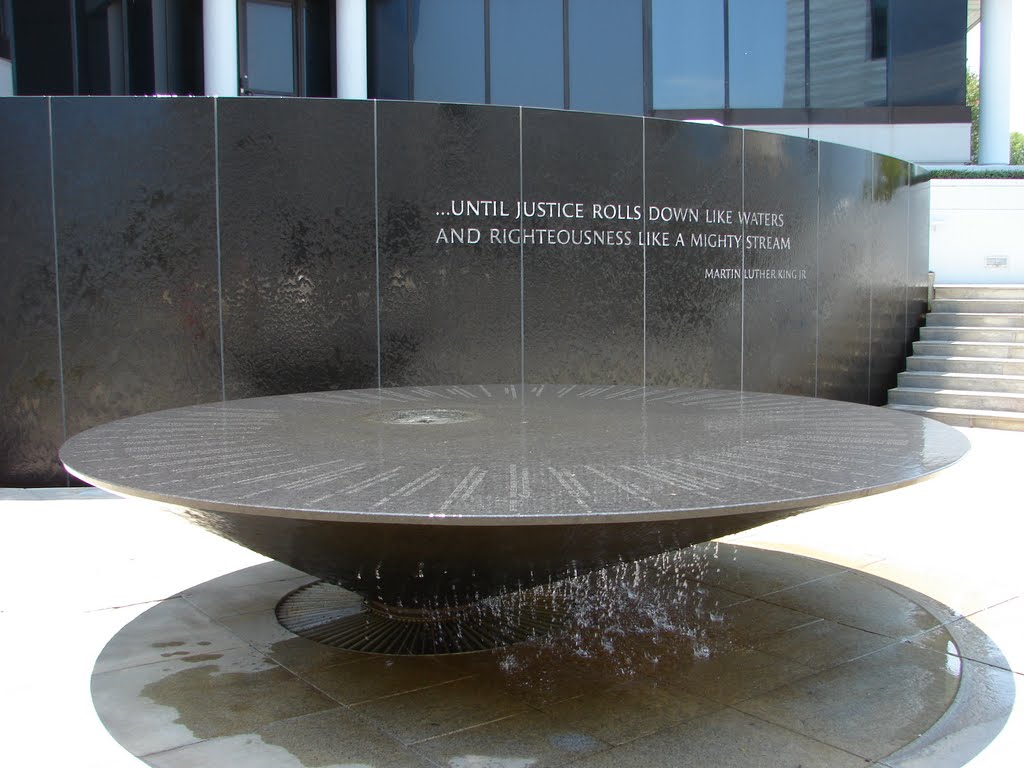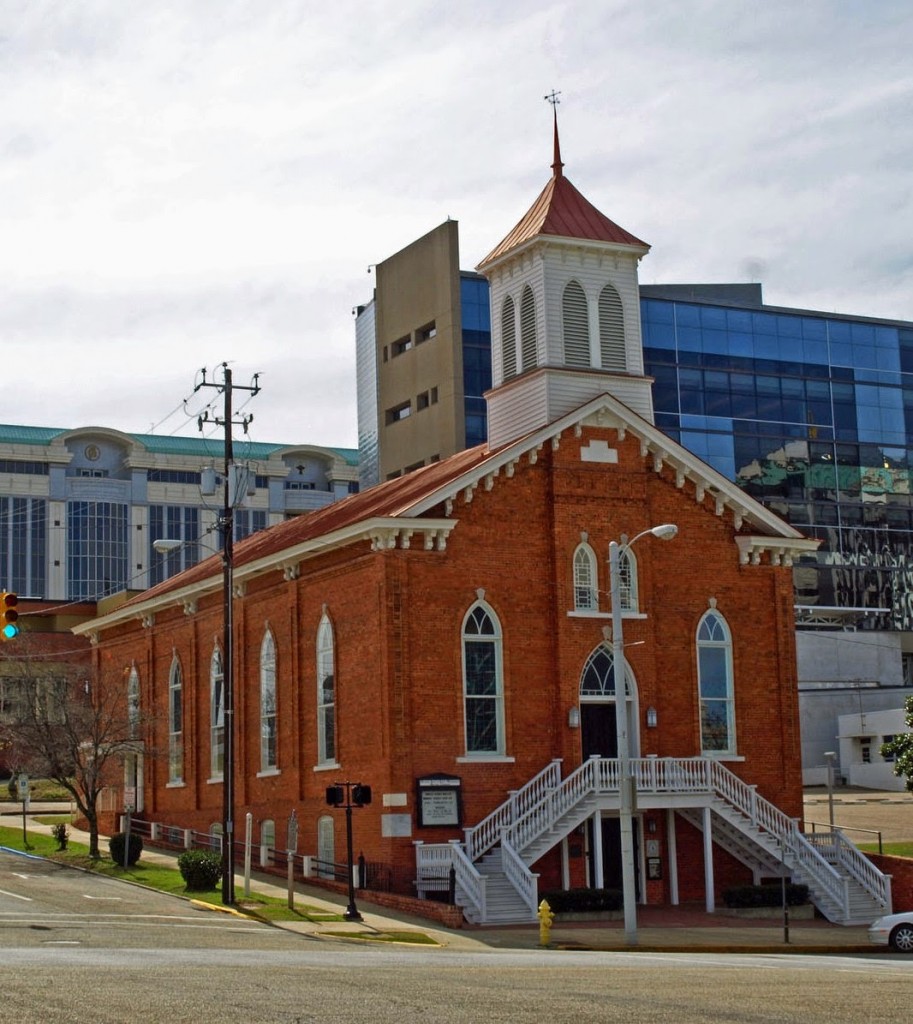The previous post ended with my rather unfulfilling stop at Martin Luther King, Junior’s house but I had to move along so I walked a few blocks past Alabama’s state capitol building to reach the National Civil Rights Memorial and Memorial Center. The Memorial itself was designed by Maya Lin who also designed the Vietnam Veteran’s Memorial in Washington, DC. In many ways this memorial is evocative of her earlier design. Both works are black granite with names etched in the stone. Both invite visitors to seek out and touch specific names or simply to touch names at random.
Unlike the Vietnam Memorial which is a long V-shaped wall embedded in a hillside, the Civil Rights Memorial is circular, in two parts, with names of victims and events inscribed chronologically on the disc. Working with the Southern Poverty Law Center (SPLC), Lin selected victims who were killed because they were active in the civil rights movement or who were killed hoping their murder would intimidate African Americans or other civil rights activists. She also chose victims whose deaths helped to galvanize the civil rights movement.
The first person named is Reverend George Lee who was among the first African Americans to register to vote in Humphreys County Mississippi. After refusing an offer of protection from white officials if he ceased his voter registration efforts, Lee was murdered in May of 1955.
The inscriptions end with the name of Doctor King who was, of course, murdered in Memphis in April 1968. There’s a noticeable gap between the names of King and Lee that, with the circular form, may symbolize that the struggle hasn’t ended and perhaps never will. Water flows over the entire memorial inspired by a phrase from King’s “I Have a Dream” speech…

I walked into the Memorial Center which is operated by the SPLC without having taken the time to touch any part of the memorial itself because I knew I’d return to it before I left Montgomery.
The SPLC was founded by Morris Dees in 1971 and is probably best known for tracking and exposing the activities of hate groups and for winning a $7 million judgement in a lawsuit filed against the United Klans of America after members of that organization randomly chose a young African American man, abducted him, cut his throat, and hung his body from a tree. This happened not in the distant past but in 1981. How much further, I wondered once again, do we yet have to travel?
The Center itself is more a tribute to many of the people who died or made other sacrifices trying to advance the cause of civil rights. I think I was most deeply affected by the number of people whose names remain unrecognized but whose sacrifice was as great as those of James Chaney, Andrew Goodman, or Michael Schwerner. Another moving feature of the Center is the opportunity to enter your name to scroll electronically on the Wall of Tolerance pledging to take a stand against hate and

injustice.
One element I looked for that was either absent or that I missed was a display about the so-called Reverse Freedom Rides of 1962. Organized from New Orleans by George Singlemann these rides lured local Black citizens onto northbound buses bound for places like the Kennedy compound in Hyannis Port with false promises of waiting jobs and housing awaiting their arrival. Meant as a counterpart of the highly publicized Freedom Rides intended to integrate southern bus stations Singlemann said it was time for the north to “put up or shut up.”
Exit the museum, cross Washington Street at the corner of Decatur Street, and walk one block down the hill to reach the Dexter Avenue Church. This is the only church in his career where Martin Luther King, Jr. was the sole serving pastor and was, of course, the pulpit from which the young Doctor King practiced and perfected his oratory. Just after I tugged on the church door and found it locked, I noticed a sign indicating a tour at 13:00. When I pulled out my cell phone and looked at the time, it was about 13:15. I thought, “I’d really like to visit inside but I’m not waiting until tomorrow.”
Once again, I took a few pictures and was about to leave when a woman stepped outside. She saw me and told me she had a group viewing a brief film and was looking for another tour group expected at any moment. She introduced herself as Wanda Battle and invited me to join the next tour. Given my time constraints, I politely declined but asked if I might be able to sit in the sanctuary for a few moments. She explained that the policy was not to allow individuals into the church when they were not part of a tour. I told her I understood and thanked her.

We continued chatting as she waited and I shared some of my experiences and emotions from my time in Memphis and Mississippi. We talked about my thoughts when I visited the site of Bryant’s Grocery and I showed her the pictures I had taken at the site. For the second time that day, I thought of Trayvon Martin.
At some point during our conversation, she had a change of heart and offered to take me inside the church. She told me that the church still has a small but active congregation of about 150 members who attend regular Sunday services. She pointed out the two stained glass windows that were original and told me that all the others had been replaced but that care had been taken to try to reproduce the originals as closely as possible. Unfortunately for me, no photos are allowed in the church. Still, I sat for a moment and imagined myself listening to King preach and hearing him help organize the Montgomery bus boycott. On our way out I thanked her for bending the rules and promised to email the pictures from Money.
Looking at the church as I walked away, I began to think about the intersection of religion and politics in American history. Reading this, you can no doubt discern my admiration for the role religion played in the American Civil Rights movement. Conversely, I feel some disdain for other political stances taken by some religious groups because they espouse a dissonant world view from my own. I began wondering about the rationality of approving one type of church and state interaction while disapproving of another. It’s a question with no easy answer and one I will continue pondering.
I had two brief stops remaining before leaving Montgomery. The first was to walk half a dozen blocks or so down Dexter Avenue toward the Rosa Parks Museum and Library. I knew I wouldn’t take the time to visit the museum but a young man staffing the desk at the Civil Rights Memorial Center told me there was a marker at the site where Parks boarded the bus before refusing to move to the back. I found the marker, took my picture and set off back up the hill to return to my car and to the Civil Rights Memorial. It was at this time that I chose to touch the names and interact with the memorial as Lin intended. I thought of it as making a final farewell.

With this gesture, the trip had effectively come to its end. I knew I had about 800 miles left to drive and I knew I’d enjoy visiting my family in Atlanta. I was also relieved I’d need no more plans. No more notes for this chronicle. And only five photos remained to be taken – all to be added to the “Welcome To” folder. In a bit over 30 hours, I would feed my cat, be able to sleep in my own bed, and not worry about unpacking until the following morning.
By the numbers:
Duration of the trip: 21 days.
Total miles driven: 6,440 (10,365 km) (I passed 2,000 miles on the second day; 3,000 miles on day 5; 4,000 miles on day 13; 5,000 miles on day 19; and 6,000 miles on day 21.)
Average miles per day: 306.67 (After reaching home, I needed 15 days to drive 306 miles and that included 2 round trips to Baltimore!)
Gallons of gas used: 129.121.
Average price per gallon: $3.52.
Average miles per gallon: 49.875.
States I visited: 13 (South Dakota, North Dakota, Minnesota, Wisconsin, Iowa, Illinois, Missouri, Tennessee, Arkansas, Mississippi, Louisiana, Alabama, Georgia).
States I drove through without visiting: 7 (Pennsylvania, Ohio, Indiana, Kentucky, South Carolina, North Carolina, Virginia).
Mississippi River crossings: greater than 30.
Different microbrews sampled: 15.
Blues Trail markers I photographed: 12 (10 in Mississippi and 2 in other states).
Treasures of the Great River Road signs I photographed: 8.
Writers homes I visited: 3 (Mark Twain, William Faulkner, F Scott Fitzgerald).
Specific movie locations I visited: 3 (Big Fish, Field of Dreams, Windsor Ruins).
Towns I passed named Toddville: 1.
Pictures taken: Approximately 1,100.
Pictures used: 931.
Words in the Great River Road and More 2014 journal: More than 35,000.
Date I added the “Welcome to Pennsylvania” photo: 29 August 2014.